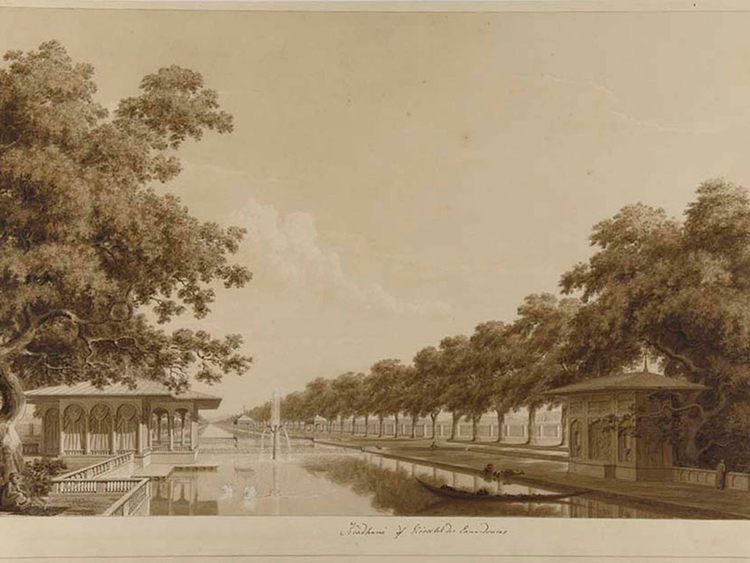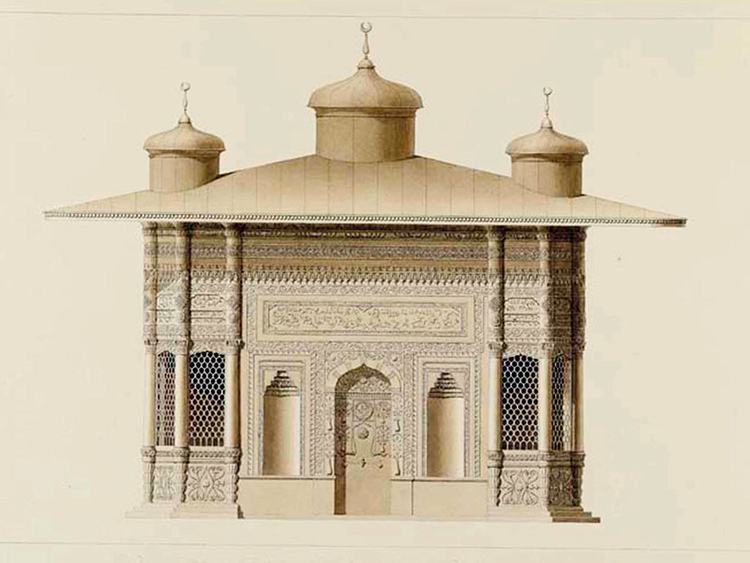
An exhibition showcasing a collection of rare and uniquely intricate drawings depicting what life was like in the Ottoman city of Istanbul has opened at the Sharjah Museum of Islamic Civilization.
Titled Thomas Hope: Drawings of Ottoman Istanbul, the show is being held in collaboration with Benaki Museum in Athens, Greece.
Hope (1769-1831) was a member of a family of bankers of Scottish descent. He was an exceptional designer, author and art collector. He also built up unique and extensive collections of antiquities, sculptures and European paintings and was an expert in the fields of architecture and decoration who overturned the artistic norms of his time, leaving his mark on the period of the Regency.
The exhibition examines the life, times and discoveries of Hope as he toured Europe. Visitors will be able to read the detailed notes he made to accompany his collection of drawings and document his travels.
There are 60 selected artworks by Thomas Hope at the Sharjah exhibition, which is part of a larger collection at the Benaki Museum. The exhibition was initially shown in Athens last year, curated by Dr Fani-Maria Tsigakou, Emeritus Curator of the Benaki Museum, and Mina Moraitou, curator of the Benaki Museum of Islamic Art.
In Sharjah, Moraitou was present to represent the Benaki Museum during the inauguration of the exhibition and introduced the works to the VIPs and other guests.
Hope’s collection of sketches and watercolours, made during his extensive Grand Tour to the Mediterranean region during the last quarter of the 18th century, wonderfully capture everyday life in the bustling Ottoman-era city. His works on paper depict people, buildings and streets in great detail and therein lies the value of his work.
Visitors to the exhibition will be able to view panoramas of Istanbul, scenes from its different neighborhoods as well as depictions of the city’s stunning Ottoman palaces, mosques, fountains and grand public buildings.
When Hope visited Istanbul, he found a cosmopolitan city that was home to foreigners from Europe and beyond. Their presence, together with that of Muslim, Christian and Jewish subjects of the Ottoman Empire, helped to create the city’s wonderfully multicultural population.
Hope drew some of the best-known mosques of the old city. Some of these were captured in individual drawings, while others were sketched towering over the city’s sprawling landscape of buildings.
He also drew scenes of everyday life with people in the street, in the shops in the marketplace, in the coffee houses, women with children, pedlars, fishermen.
“He also depicted the costumes of various officials and of various types who circulated in the Ottaman capital. These representations of costumes bespeak Hope’s scholarly interest in dress, which he was to reveal a few years later in the publications Costume of the Ancients and Designs of Modern Costume,” notes Dr Tsigakou.
A year’s sojourn
Hope spent almost a year in Istanbul, admiring and drawing the main attractions. His works remained in his library until his death in 1831. They were later sold off at an auction hosted by his family. Scholars believed they had been lost. However, they were in fact purchased in the 1930s by Antonis Benakis, founder of the Benaki Museum, and kept in the Museum Library.
It was thanks to Dr Tsigakou’s painstaking research and ‘detective work’ that the entire collection was found in the Benaki Museum Library.
Since no diaries or letters about Hope’s travels have survived, the artist’s works are the only records for the places he visited. At that time, the Ottoman Empire was ruled by Sultan Selim (1789-1807), a cultured and progressive ruler.
Dr Tsigakou notes that Hope’s renderings of the city “are far superior to those of his other compatriots” who visited the city during that period.
For researchers into Ottoman culture, the Thomas Hope Archive is “one of the earliest and the most complete of visual testimonies,” and “a veritable treasure trove.”
Dr Tsigakou observes that given that most of the European artists-travellers who immortalised the Eastern Mediterranean region descended there during the 19th century, Hope’s drawings are one of the earliest.
She also notes that the thematic range of his drawings is unprecedented.
As Mina Moraitou comments: “Thomas Hope’s drawings are some of the most important pieces we have at the Benaki Museum. We are delighted to be able to bring them to the UAE and exhibit them at the Sharjah Museum of Islamic Civilization for the first time.”
Speaking to Weekend Review, Moraitou says the exhibition offers “an invaluable material for the art historian, architecture and art students to be able to study and see these pieces here.”
“Hope was one of the European art lovers who were very much interested in the past. So they would perform the Grand Tour, the customary travel in the Middle East comprising Greece, Turkey, Syria, Egypt and they would record antiquity ‘in situ’. And this is like a time capsule of how things were back then. Hope is interested also in the form of the buildings as well as in the decorations.
In the everyday life, he depicts many figures — the different kinds of figures who would walk about those days in the capital. Because in Istanbul, in the 18th century, you had Muslims, Christians and the Jews, but also you have European traders and European visitors. So it was a colourful combination of different types of people. And he records them with their costumes and different headdresses in great detail.”
“In many, many cities in the Middle East, including here in the United Arab Emirates, you see this multiculturalism and how the interactions of different types of people of different religions, of nationalities is still going on as it was in Istanbul or in Cairo centuries ago.”
About the impact of Hope’s work in England, Moraitou says: “Hope was a designer as well. When he went back home, he used these designs to create his own line of furniture. So his sojourn to the Orient was a two-way exchange.”
“What I would be very happy [about] is that here people would make the most out of it, because it is a really unique body of works and the knowledge you can get out of it is very important. So I hope people will come and have a look at this exhibition.”
“The Sharjah Museums Authority is delighted to host Thomas Hope: Drawings of Ottoman Istanbul, which offers visitors to the Sharjah Museum of Islamic Civilization the opportunity to see what life was like in one of the world’s most important and vibrant cities,” says Manal Ataya, Director General of Sharjah Museums Authority.
Thomas Hope: Drawings of Ottoman Istanbul will be on show at the Sharjah Museum of Islamic Civilization until February 10.














